
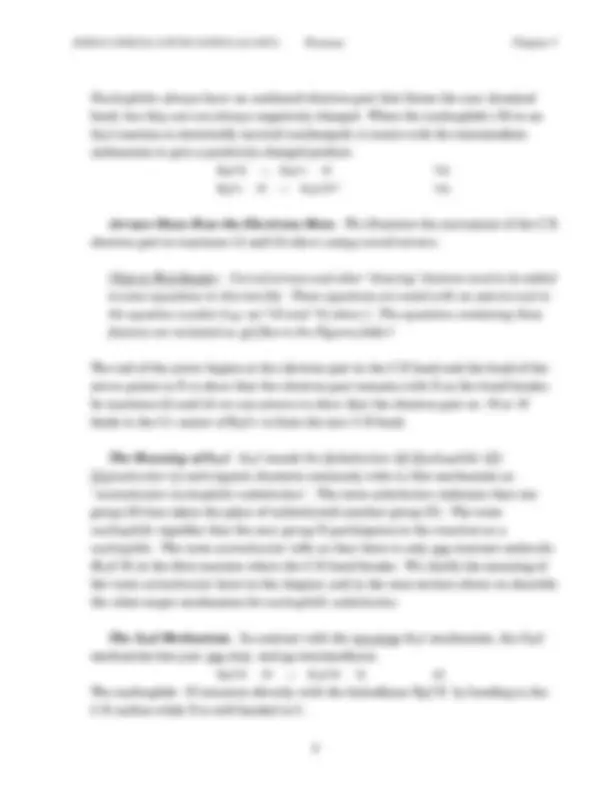
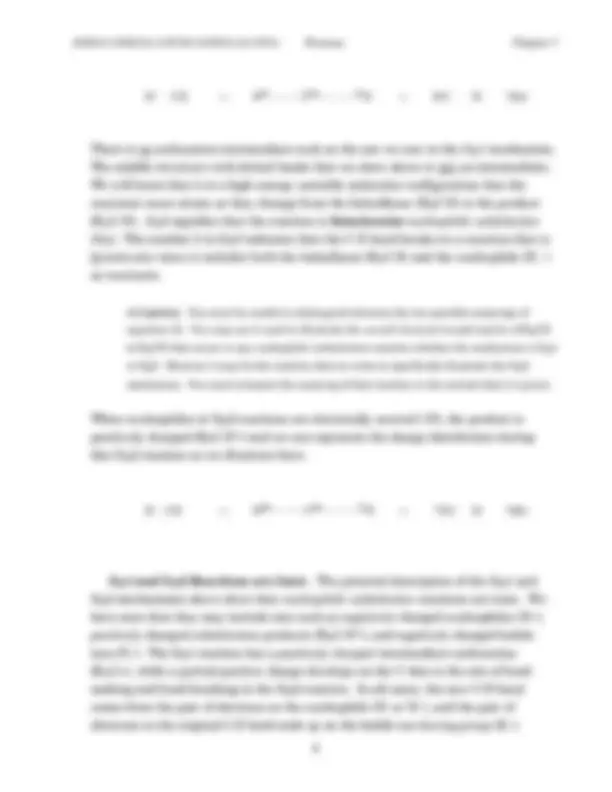
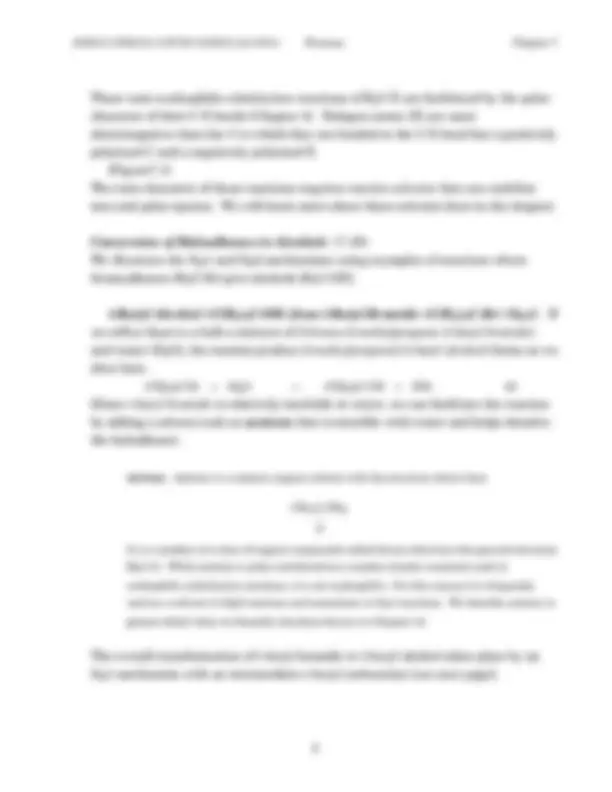
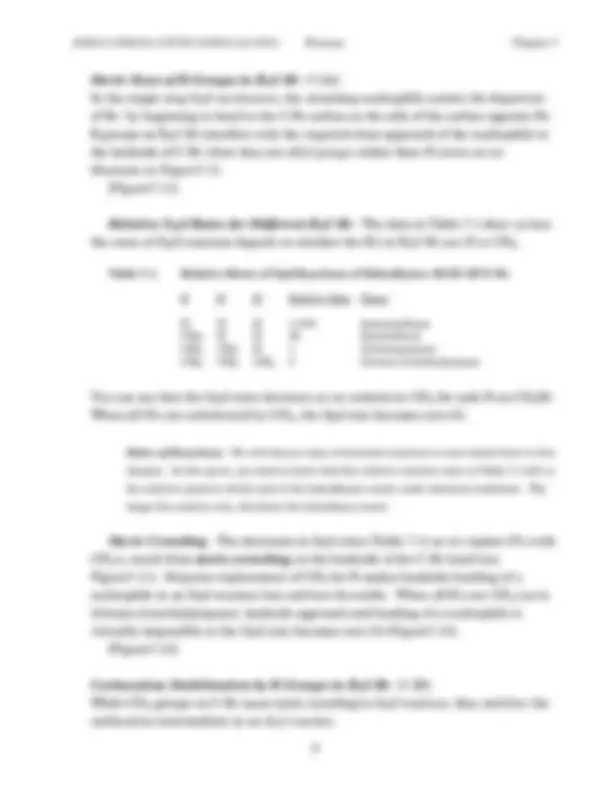
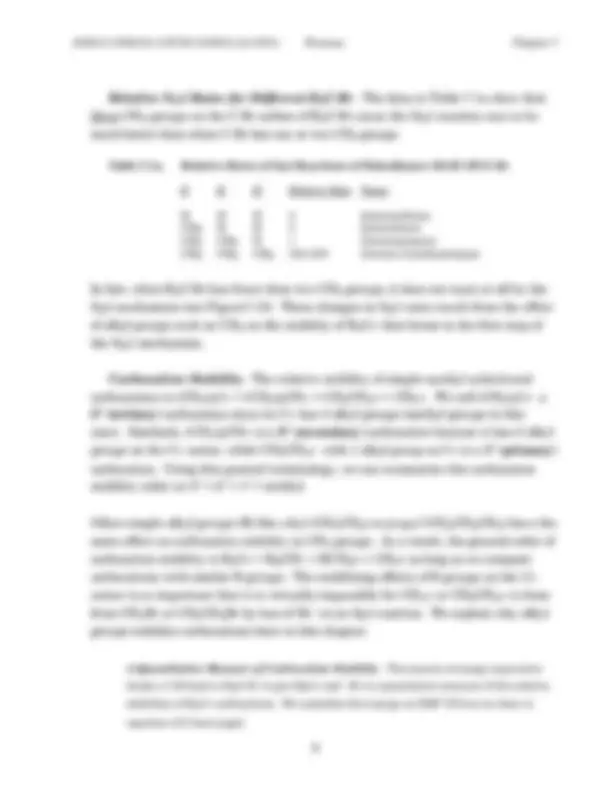
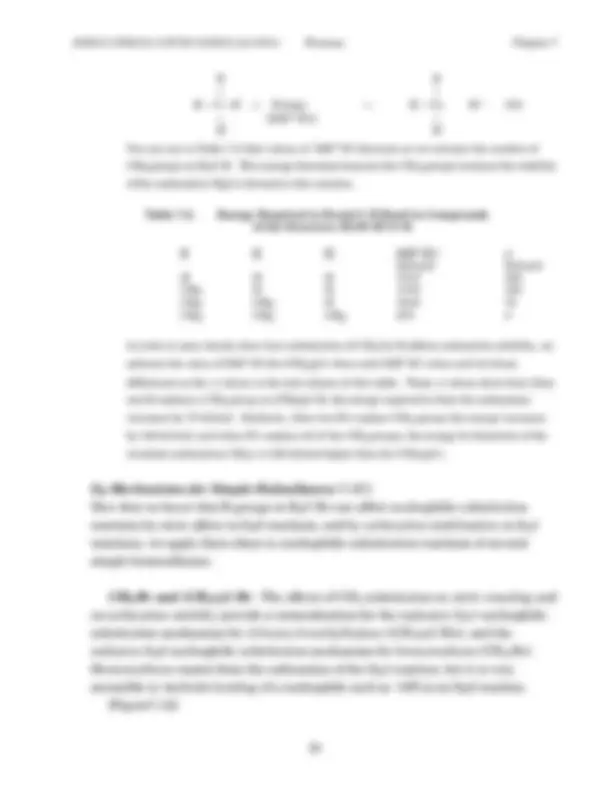
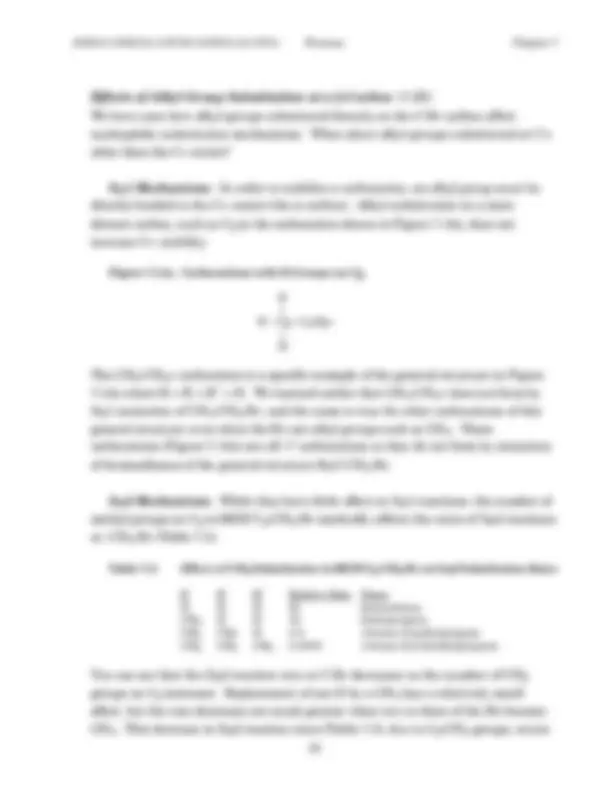
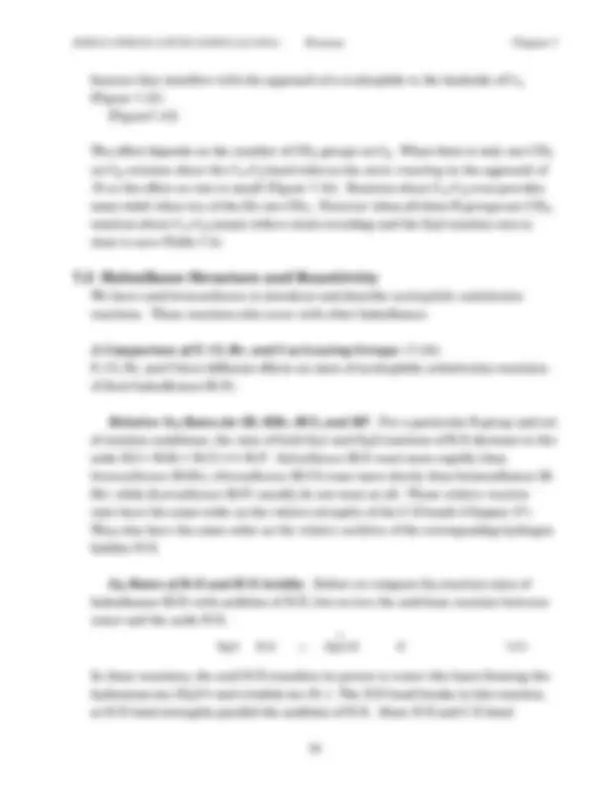
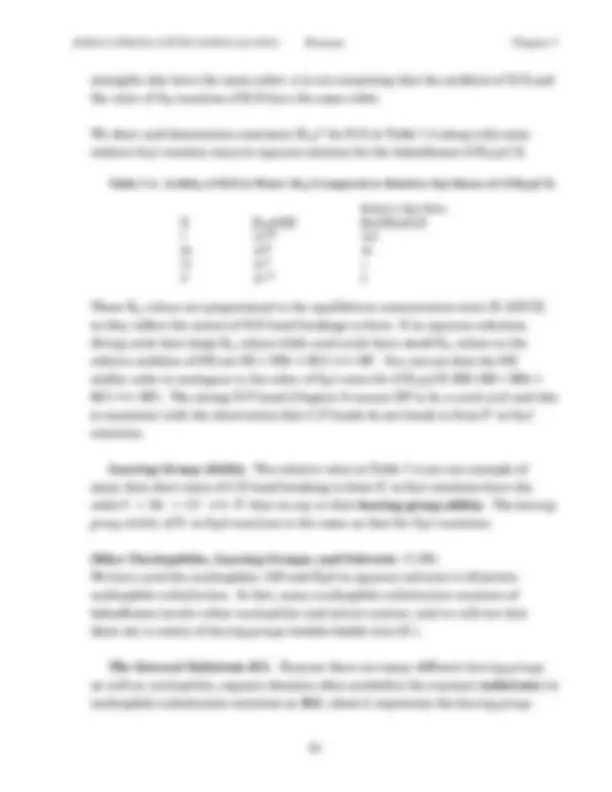
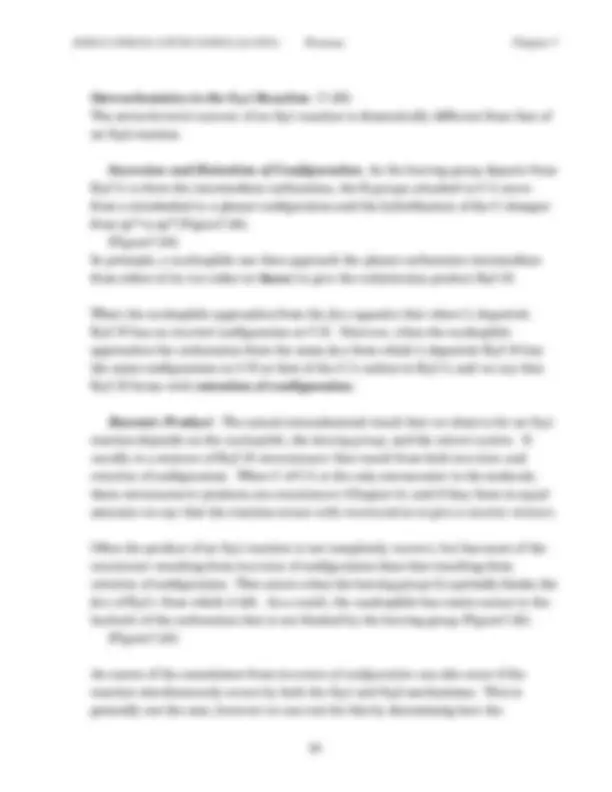
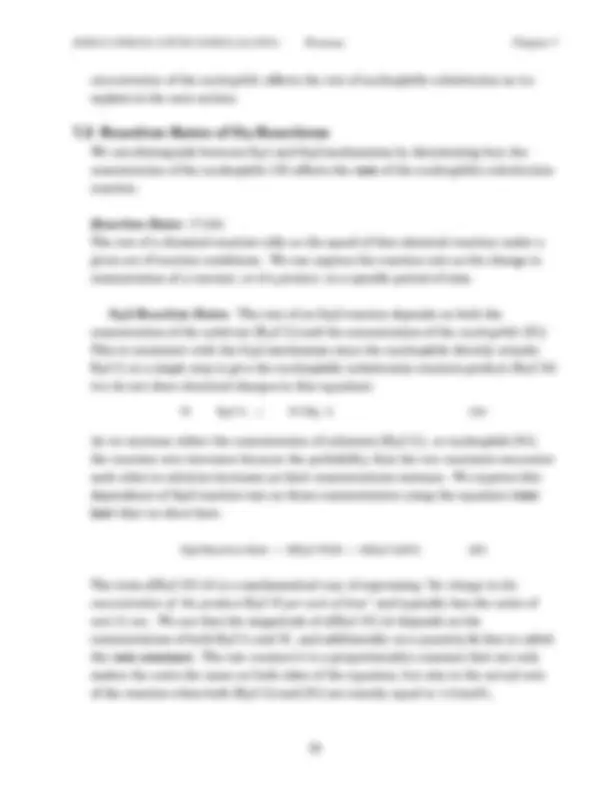
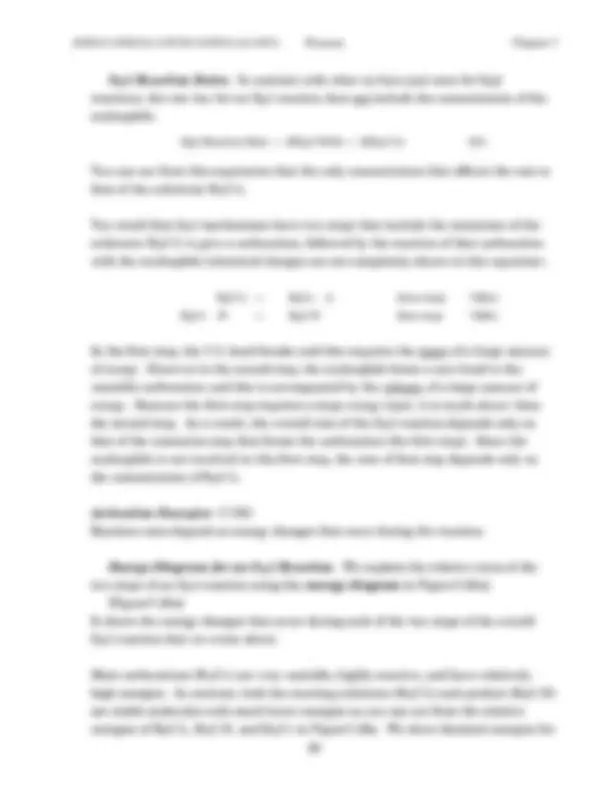
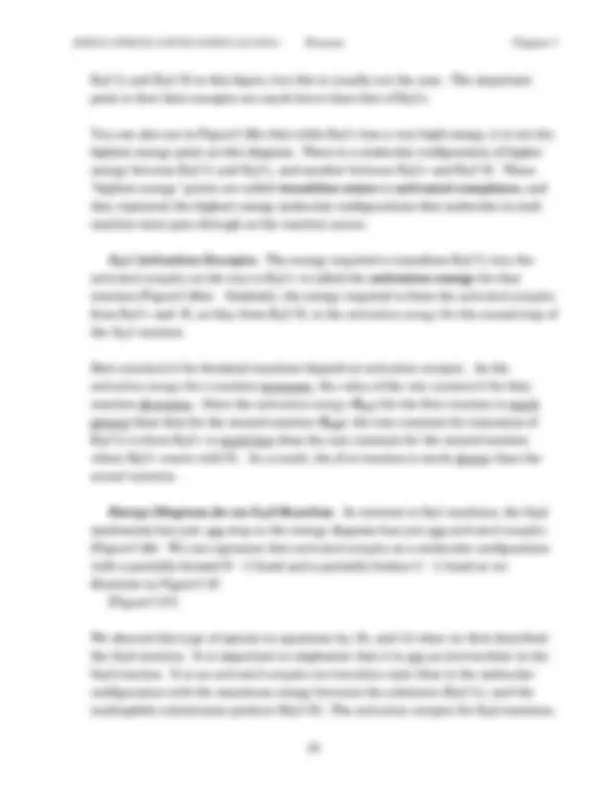
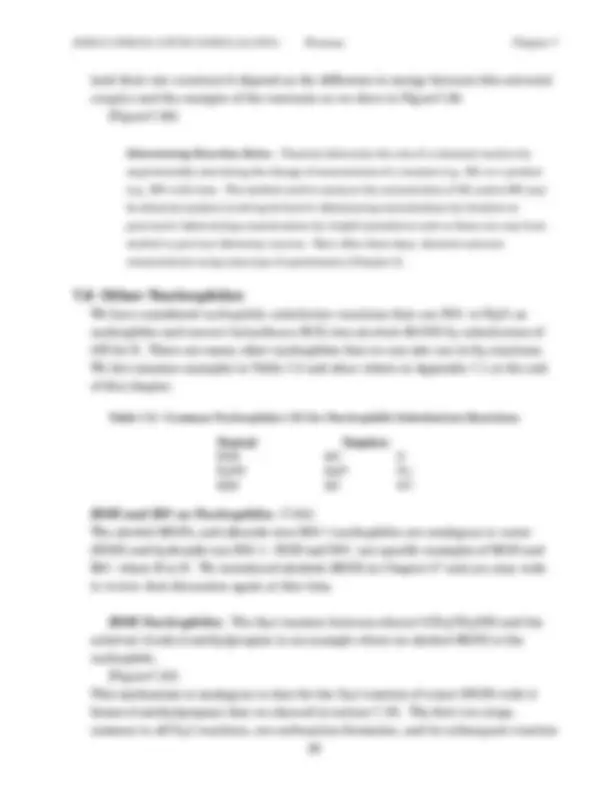
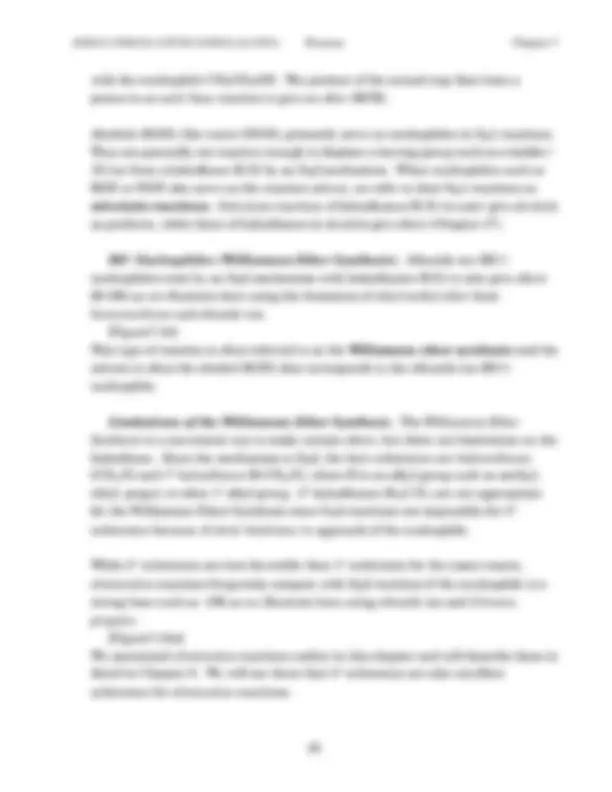
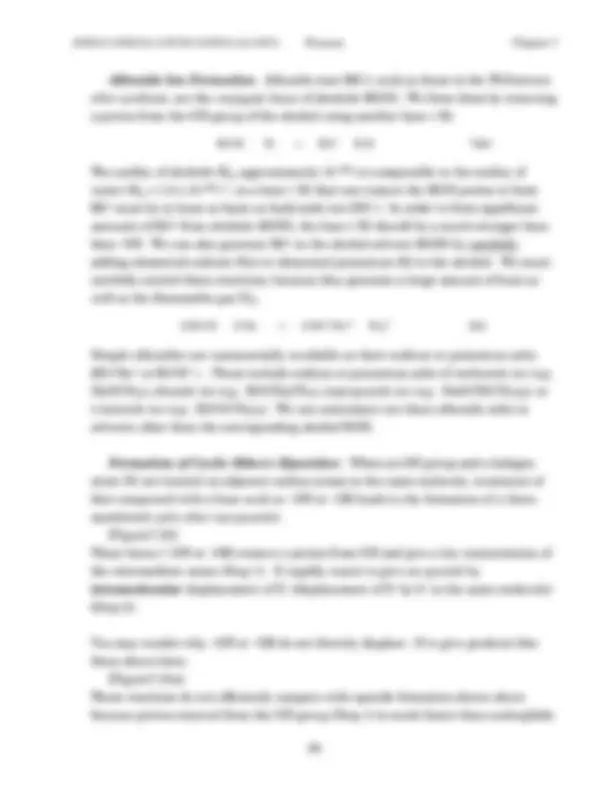
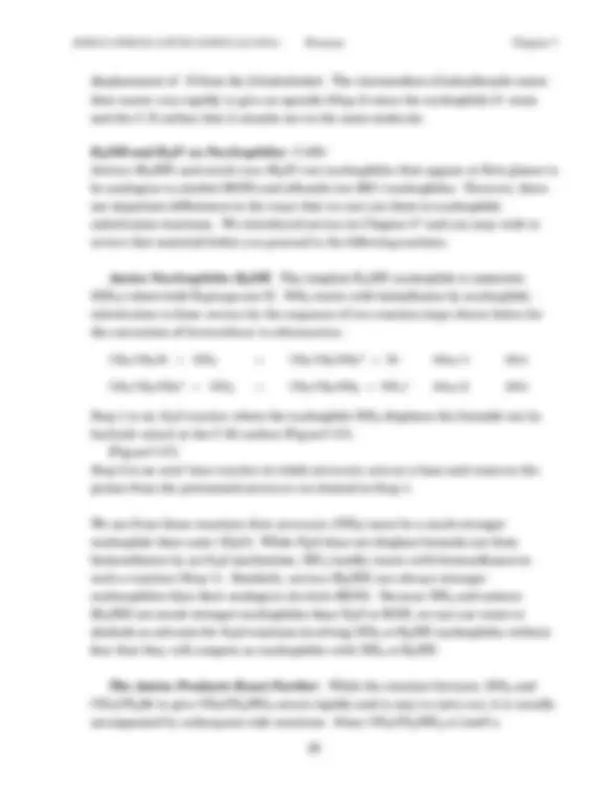
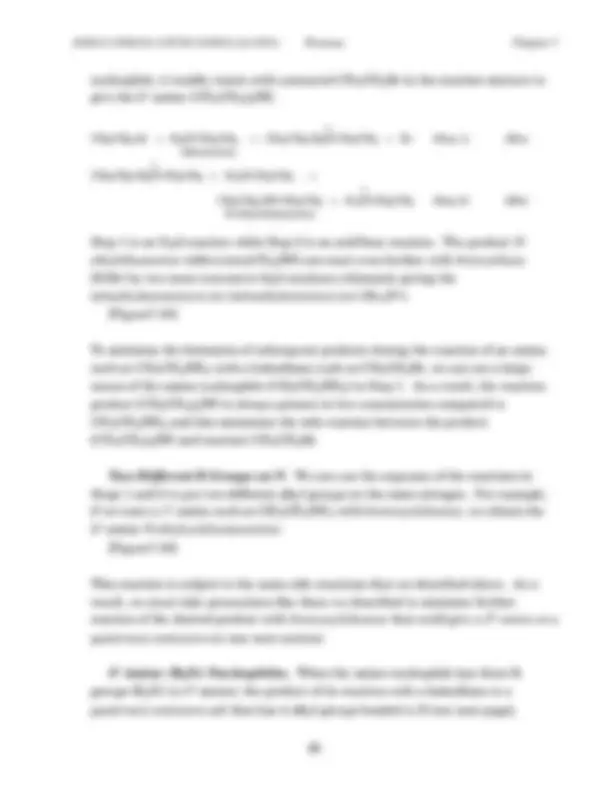
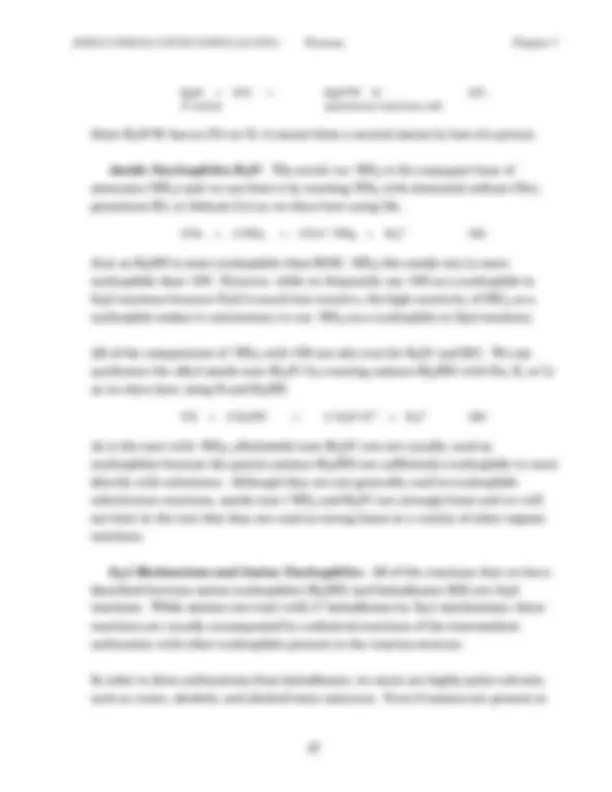
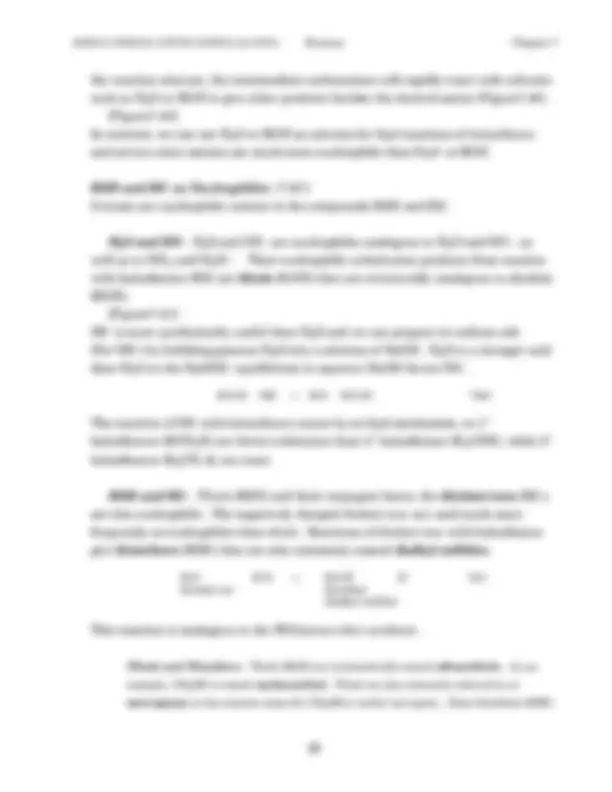
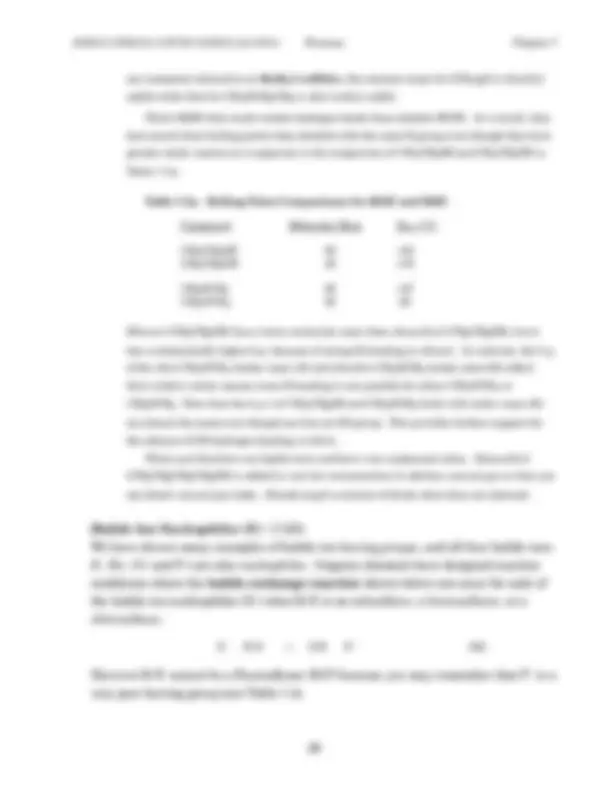
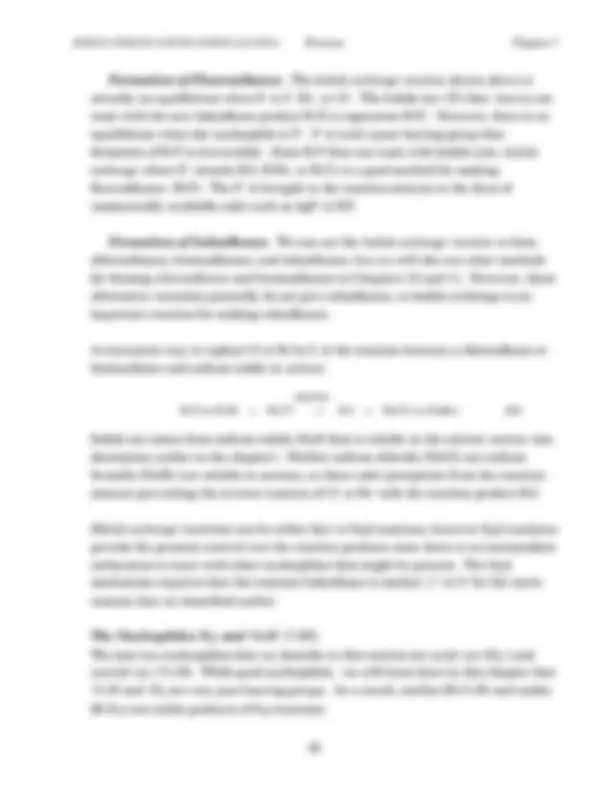
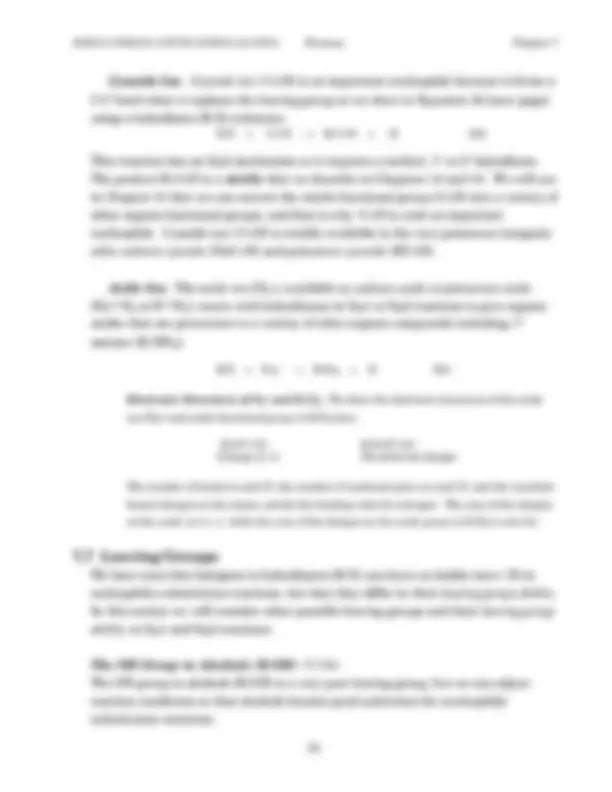
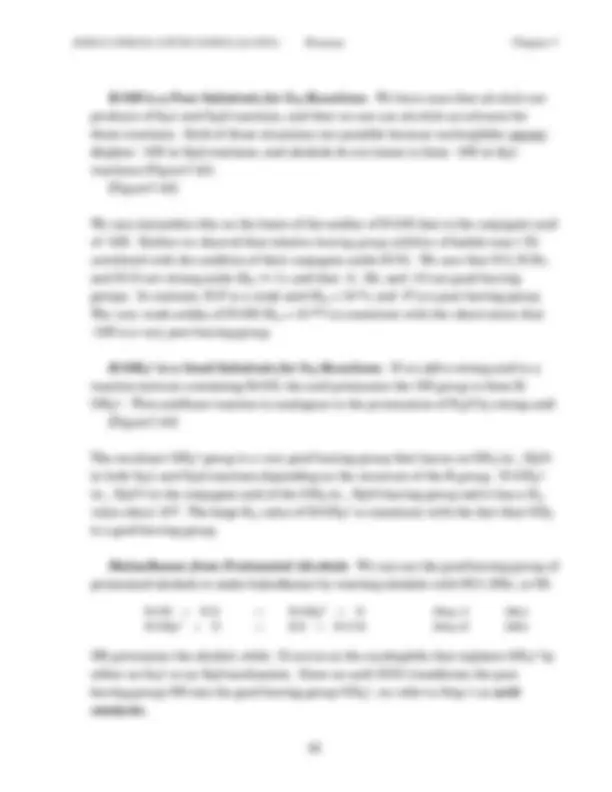
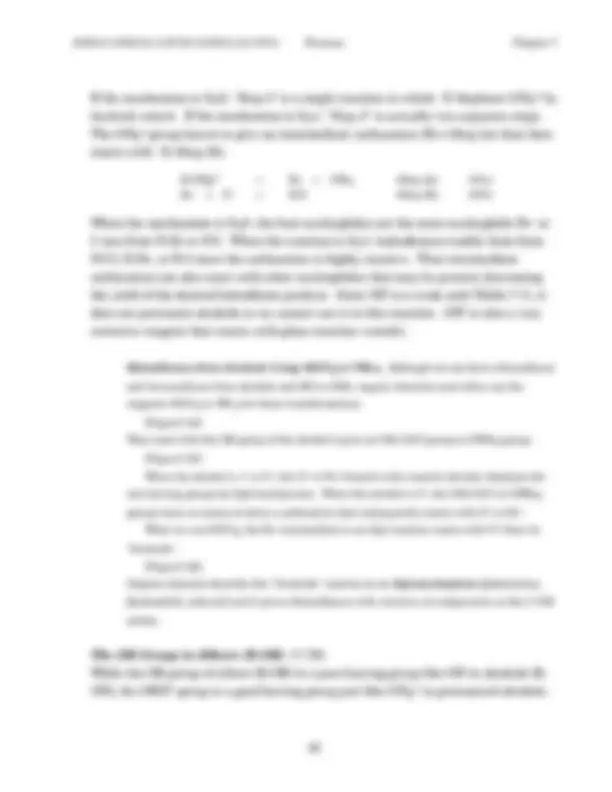
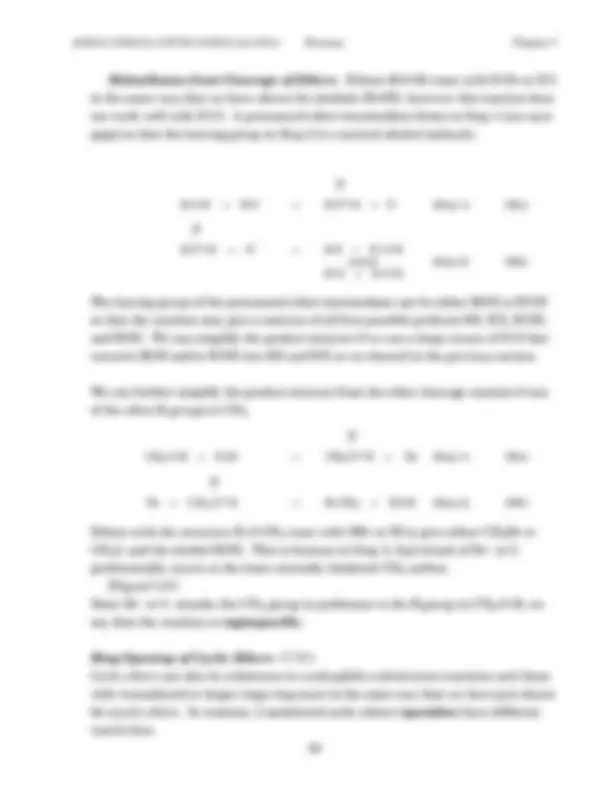
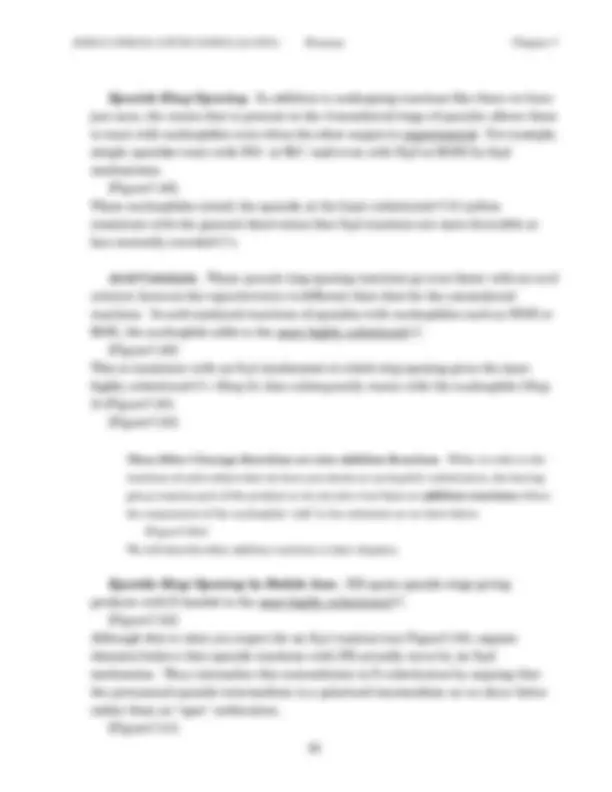
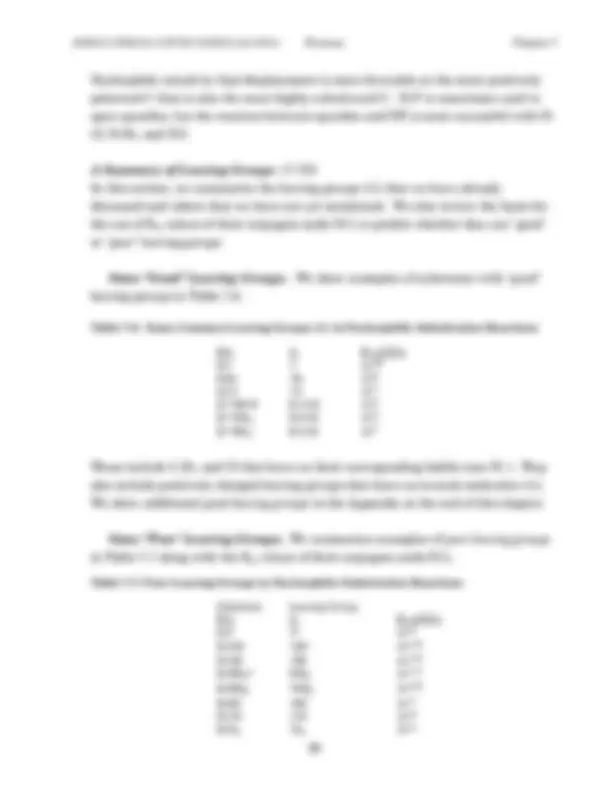
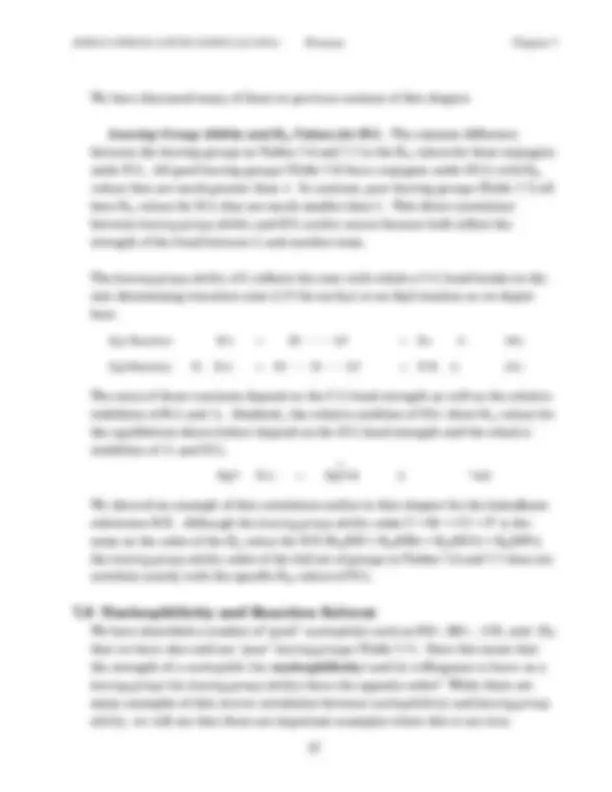
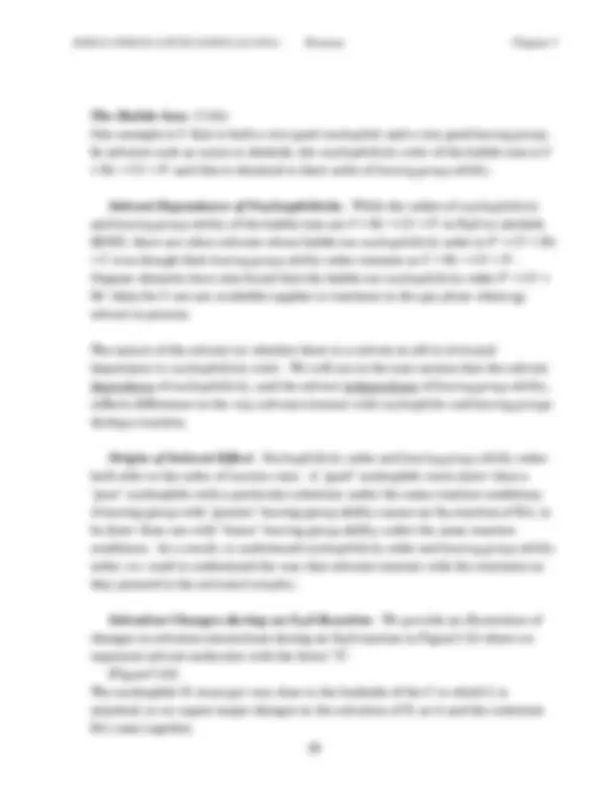
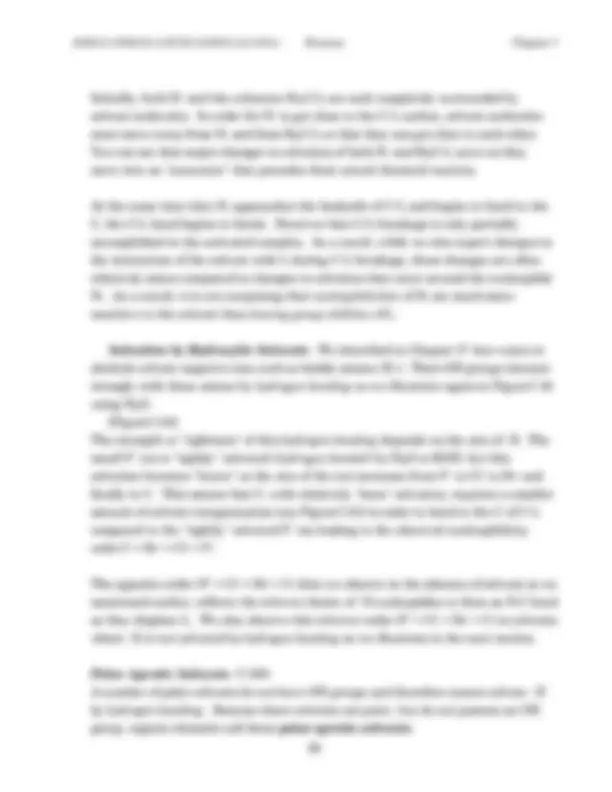
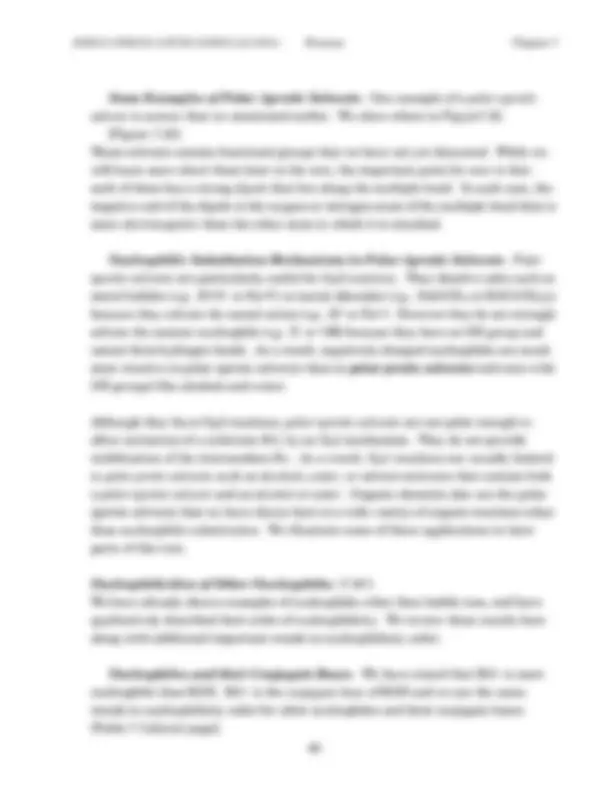
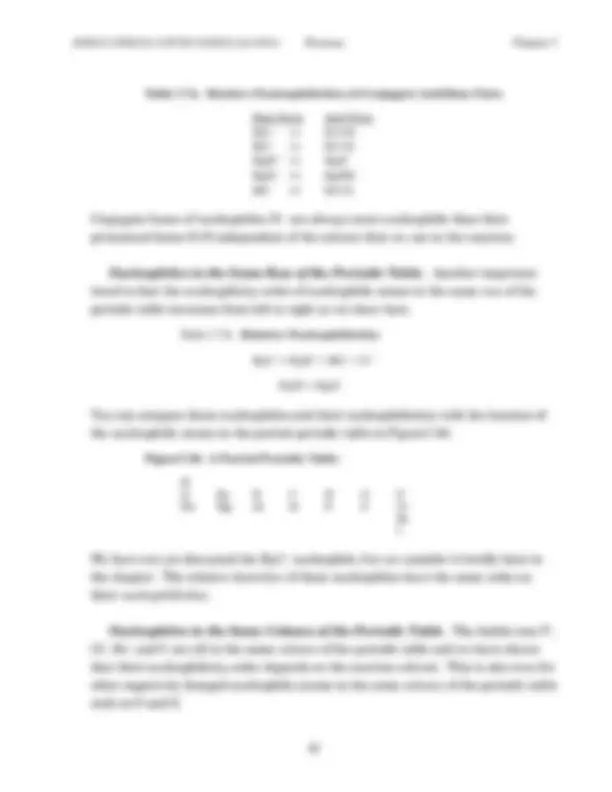
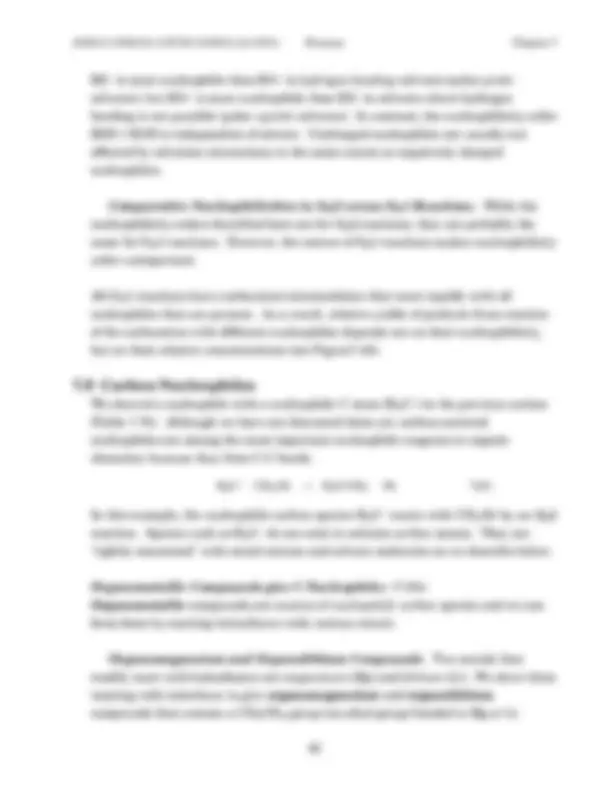
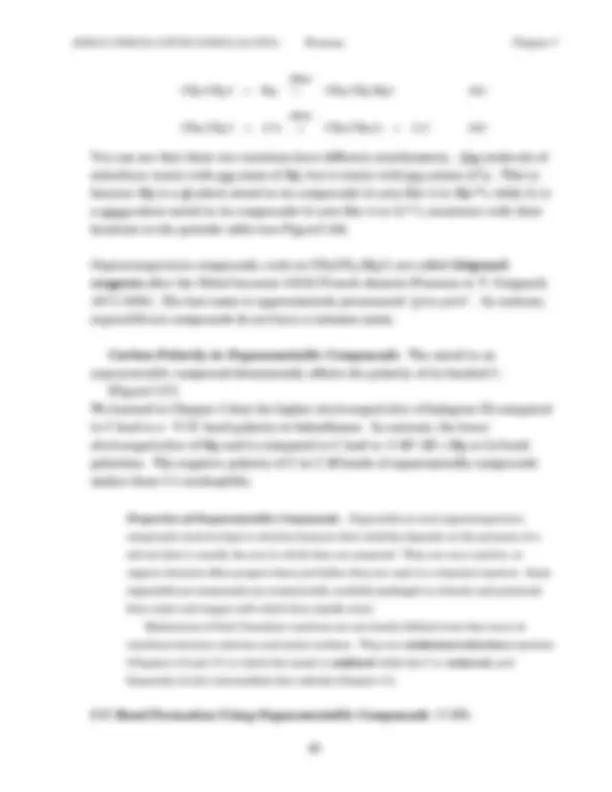
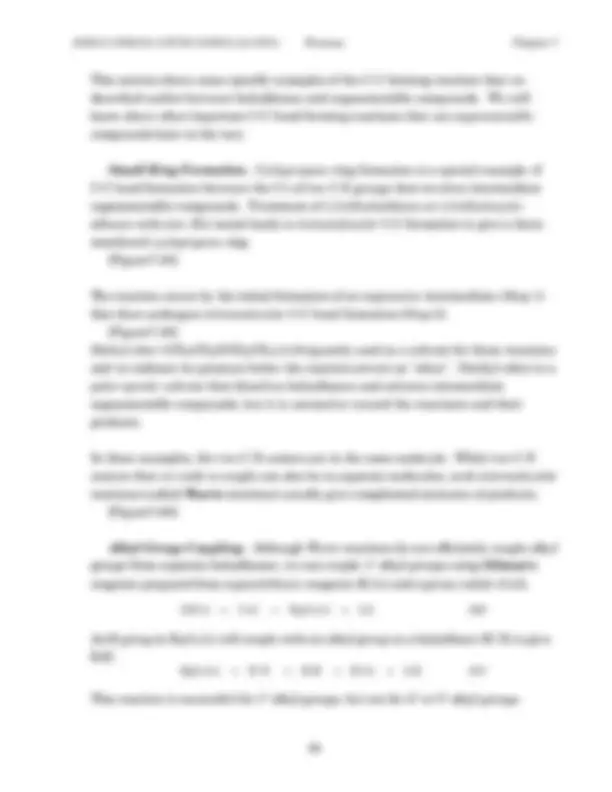
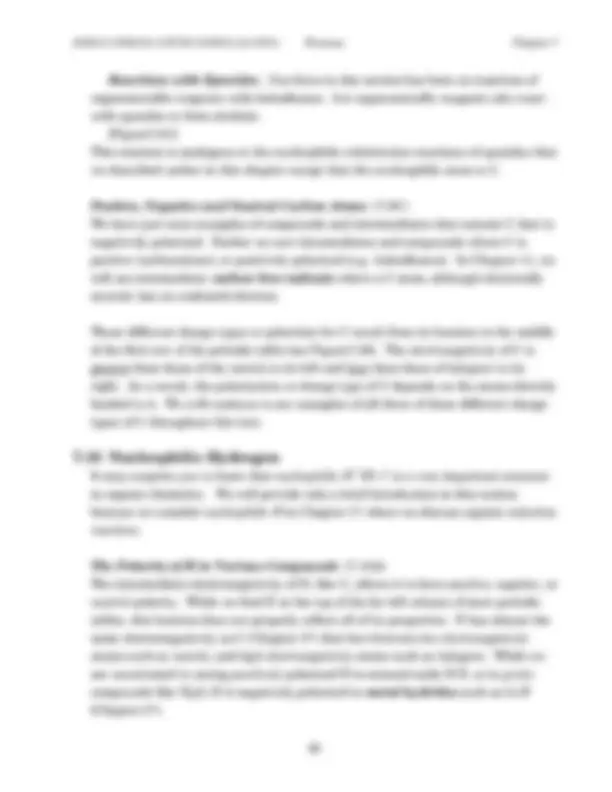
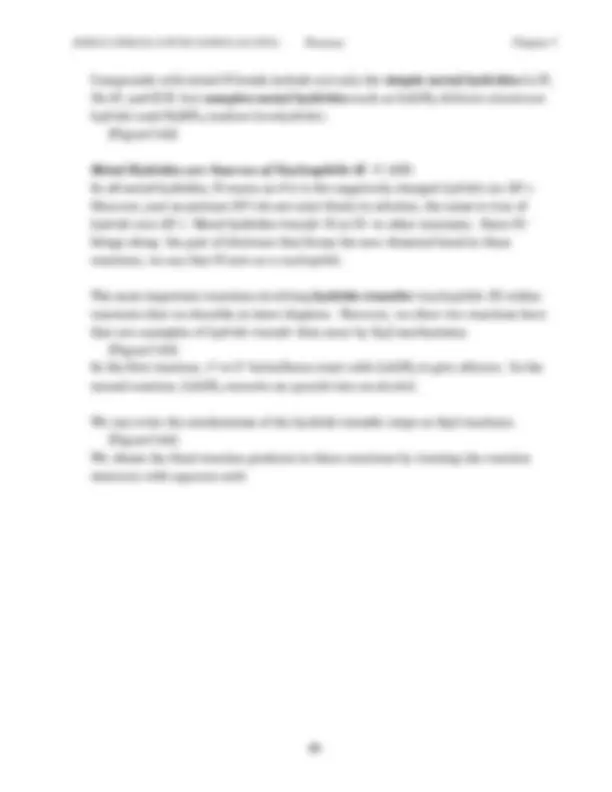
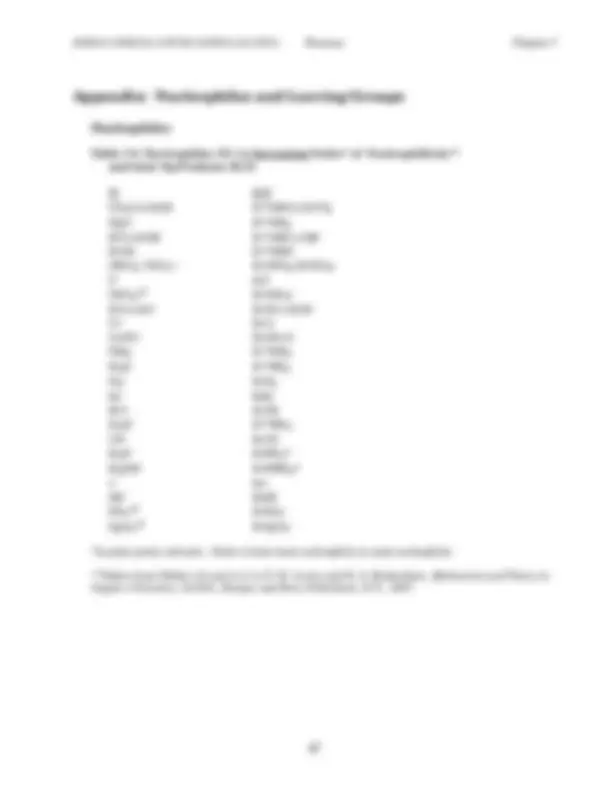
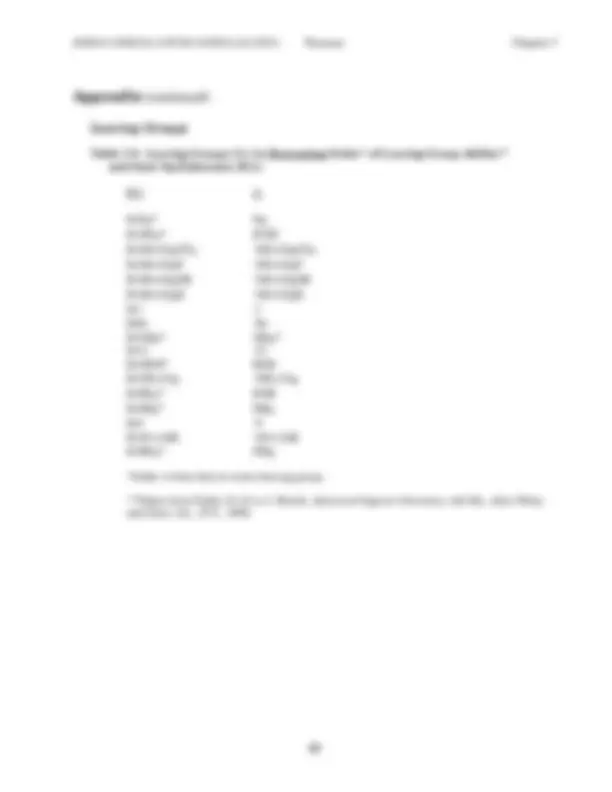
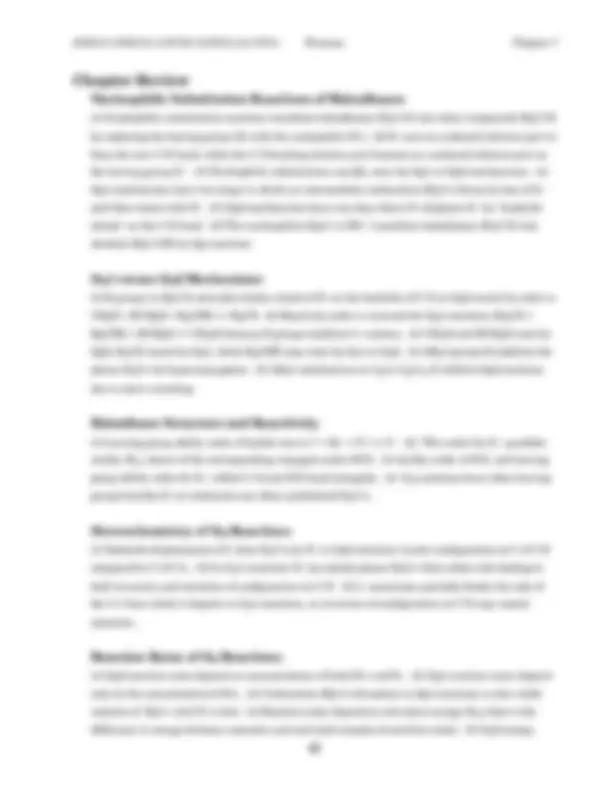
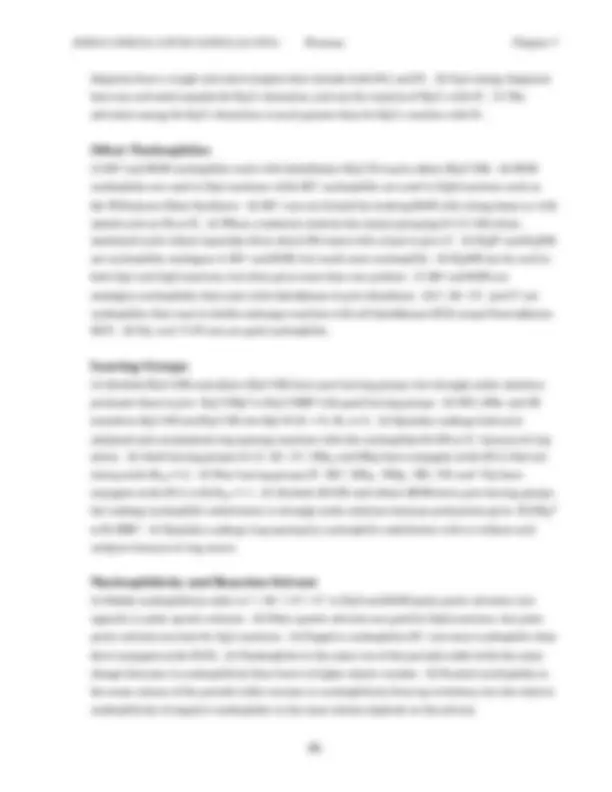



Study with the several resources on Docsity

Earn points by helping other students or get them with a premium plan


Prepare for your exams
Study with the several resources on Docsity

Earn points to download
Earn points by helping other students or get them with a premium plan
Community
Ask the community for help and clear up your study doubts
Discover the best universities in your country according to Docsity users
Free resources
Download our free guides on studying techniques, anxiety management strategies, and thesis advice from Docsity tutors
This chapter explores nucleophilic substitution reactions, focusing on haloalkanes and their mechanisms (SN1 and SN2), reaction rates, stereochemistry, and various nucleophiles and leaving groups. The document also discusses the role of solvents and their effects on these reactions.
What you will learn
Typology: Study notes
1 / 51

This page cannot be seen from the preview
Don't miss anything!












































•Nucleophilic Substitution Reactions of Haloalkanes •SN1 versus SN2 Mechanisms •Haloalkane Structure and Reactivity •Stereochemistry of SN Reactions •Reaction Rates of SN Reactions •Other Nucleophiles •Leaving Groups •Nucleophilicity and Reaction Solvent •Carbon Nucleophiles •Nucleophilic Hydrogen
This chapter describes nucleophilic substitution reactions of haloalkanes, alcohols, amines, and compounds related to them. These are ionic reactions in which one group on the molecule (a leaving group ) is replaced by another group (a nucleophile ). The transformation of haloalkanes (R-X) into alcohols (R-OH) where an OH group replaces the halogen (X) is an example of nucleophilic substitution.
Most nucleophilic substitution reactions take place by either the SN 1 or the SN 2 mechanism. The SN 1 mechanism has an intermediate carbocation with a positive charge on a carbon atom. Carbocation intermediates are planar and stabilized by alkyl groups. The SN 2 mechanism has no intermediates and occurs in a single step. We can distinguish SN 1 and SN 2 mechanisms by their stereochemistry and reaction kinetics.
Leaving groups and nucleophiles are often the same for both mechanisms, and the structure of the reactant with the leaving group (the substrate ) usually determines the reaction mechanism. The relative reactivities of nucleophiles ( nucleophilicity ) and leaving groups ( leaving group ability ) depend on their structures , their ionic charge , and the solvent.
We illustrate these nucleophilic substitution mechanisms in this chapter using a variety of chemical reactions. Besides recognizing these reactions as nucleophilic substitutions you also need to learn them as individual reactions that perform specific chemical transformations such as the conversion of a haloalkane (R-X) into an alcohol (R-OH).
Nucleophilic substitution reactions are ionic reactions that break and make chemical bonds by transfers of pairs of electrons. We illustrate this using a general representation of a nucleophilic substitution reaction in which a halogen (X) is replaced by a new group (N). R3C:X + - :N → R3C:N + - :X The color coding shows that the electron pair in the original C:X bond remains with the halogen (X) as that bond breaks, while the electron pair on - :N becomes the new C:N chemical bond.
Nucleophilic Substitution Mechanisms (7.1A) The two major mechanisms for nucleophilic substitution are called SN 1 and SN 2. We describe them here using haloalkanes (R 3 C-X) as the substrates.
The SN1 Mechanism. The SN 1 mechanism has two steps and an intermediate carbocation R 3 C+. R3C:X → R3C+ - :X *(1) R3C+ - :N → R3C:N *(2) In the first step, the C-X bond in R 3 C-X breaks to give a negatively charged halide ion (-:X) and positively charged carbocation (R 3 C+). The name carbocation signifies that it is a carbon cation. Carbocations are also called carbonium ions. In this ionization reaction (a reaction that forms ions), the electron pair in the C-X bond remains with the halogen (X) as the C-X bond breaks.
The intermediate carbocation reacts in the second step with an unshared electron pair on the species - :N to form the new C:N bond. We use the letter N to signify that
N:-^ C:X → Nδ-...........Cδ+............δ-X → N:C - :X *(5a)
There is no carbocation intermediate such as the one we saw in the SN 1 mechanism. The middle structure with dotted bonds that we show above is not an intermediate. We will learn that it is a high energy unstable molecular configuration that the reactants must attain as they change from the haloalkane (R 3 C-X) to the product (R 3 C-N). SN 2 signifies that the reaction is bimolecular nucleophilic substitution ( SN ). The number 2 in SN 2 indicates that the C-X bond breaks in a reaction that is bimolecular since it includes both the haloalkane (R 3 C-X) and the nucleophile (N:-^ ) as reactants.
A Caution. You must be careful to distinguish between the two possible meanings of equation (5). You may see it used to illustrate the overall chemical transformation of R3CX to R3CN that occurs in any nucleophilic substitution reaction whether the mechanism is SN 1 or SN2. However it may be the reaction that we write to specifically illustrate the SN 2 mechanism. You must interpret the meaning of that reaction in the context that it is given.
When nucleophiles in SN2 reactions are electrically neutral (:N), the product is positively charged (R 3 C-N+) and we can represent the charge distribution during this SN2 reaction as we illustrate here.
N: C:X → Nδ+...........Cδ+............δ-X → +N:C - :X *(5b)
SN1 and SN2 Reactions are Ionic. The pictorial description of the SN1 and SN2 mechanisms above show that nucleophilic substitution reactions are ionic. We have seen that they may include ions such as negatively charged nucleophiles (N:-), positively charged substitution products (R 3 C-N+), and negatively charged halide ions (X:-). The SN1 reaction has a positively charged intermediate carbocation (R 3 C+), while a partial positive charge develops on the C that is the site of bond making and bond breaking in the SN2 reaction. In all cases, the new C:N bond comes from the pair of electrons on the nucleophile (N: or N:-), and the pair of electrons in the original C:X bond ends up on the halide ion leaving group (X:-).
These ionic nucleophilic substitution reactions of R 3 C-X are facilitated by the polar character of their C-X bonds (Chapter 3). Halogen atoms (X) are more electronegative than the C to which they are bonded so the C-X bond has a positively polarized C and a negatively polarized X. [Figure7.1] The ionic character of these reactions requires reaction solvents that can stabilize ions and polar species. We will learn more about these solvents later in the chapter.
Conversion of Haloalkanes to Alcohols (7.1B) We illustrate the SN1 and SN2 mechanisms using examples of reactions where bromoalkanes (R 3 C-Br) give alcohols (R 3 C-OH).
t-Butyl Alcohol ((CH 3 ) 3 C-OH) from t-Butyl Bromide ((CH 3 ) 3 C-Br) (SN1). If we reflux (heat to a boil) a mixture of 2-bromo-2-methylpropane ( t-butyl bromide ) and water (H 2 O), the reaction product 2-methylpropanol ( t-butyl alcohol ) forms as we show here. (CH3)3C-Br + H2O → (CH3)3C-OH + HBr (6) (Since t-butyl bromide is relatively insoluble in water, we can facilitate the reaction by adding a solvent such as acetone that is miscible with water and helps dissolve the haloalkane).
Acetone. Acetone is a common organic solvent with the structure shown here.
CH3-C-CH3 O It is a member of a class of organic compounds called ketones that have the general structure R 2 C=O. While acetone is polar and dissolves a number of polar reactants used in nucleophilic substitution reactions, it is not nucleophilic. For this reason it is frequently used as a solvent in SN2 reactions and sometimes in SN1 reactions. We describe acetone in greater detail when we formally introduce ketones in Chapter 12.
The overall transformation of t-butyl bromide to t-butyl alcohol takes place by an SN1 mechanism with an intermediate t-butyl carbocation [see next page].
If this ionization reaction occurred, H 2 O would rapidly react with CH 3 + to ultimately give CH 3 -OH in steps analogous to reactions (8) and (9) that we showed for the SN1 reaction of the t-butyl cation with H 2 O. However, we can form CH 3 OH from CH 3 Br by nucleophilic substitution if we add sodium hydroxide (NaOH) (or potassium hydroxide (KOH)) to our reaction mixture. H2O CH3-Br + Na+ -:OH → CH3-OH + Na+ -:Br (11)
This reaction occurs by an SN2 mechanism in which the nucleophile - :OH directly displaces Br as a bromide ion (-:Br) as we illustrated earlier in our general representation of SN2 mechanisms. (The Na+^ cation does not directly participate in the reaction).
HO:-^ C:Br → HOδ-...........Cδ+............δ-Br → HO:C - :Br *(12)
We will learn below that, because of the different structures of their alkyl groups, nucleophilic substitution on bromomethane (CH 3 -Br) occurs only by SN 2 mechanisms, while t-butyl bromide (2-bromo-2-methylpropane) ((CH 3 ) 3 C-Br) undergoes nucleophilic substitution only by SN1 mechanisms.
H 2 O versus - :OH as a Nucleophile. While CH 3 -Br reacts with - :OH by an SN 2 reaction, it will not react with the nucleophile H 2 O because H 2 O is much less reactive (much less nucleophilic ) than - :OH. We will see later in this chapter that negatively charged nucleophiles are much more nucleophilic than neutral nucleophiles if they have the same nucleophilic atom. The nucleophilic atom is O in both H 2 O and - :OH.
Why do the haloalkanes bromomethane (CH 3 -Br) and 2-bromo-2-methylpropane ((CH 3 ) 3 C-Br) undergo nucleophilic substitution by different mechanisms? We will see here that this is a result of both the relative steric sizes of the alkyl groups in R 3 C-Br, and the way that these alkyl groups stabilize carbocation centers.
Steric Sizes of R Groups in R 3 C-Br (7.2A) In the single step SN2 mechanism , the attacking nucleophile assists the departure of Br:-^ by beginning to bond to the C-Br carbon on the side of the carbon opposite Br. R groups on R 3 C-Br interfere with the required close approach of the nucleophile to the backside of C-Br when they are alkyl groups rather than H atoms as we illustrate in Figure7.11. [Figure7.11]
Relative SN2 Rates for Different R 3 C-Br. The data in Table 7.1 show us how the rates of SN2 reactions depend on whether the R's in R 3 C-Br are H or CH 3.
Table 7.1. Relative Rates of SN2 Reactions of Haloalkanes (R)(R')(R")C-Br R R' R" Relative Rate Name H H H 1,000 bromomethane CH3 H H 30 bromoethane CH3 CH3 H 1 2-bromopropane CH3 CH3 CH3 0 2-bromo-2-methylpropane
You can see that the SN2 rates decrease as we substitute CH 3 for each H on CH 3 Br. When all H's are substituted by CH 3 , the SN2 rate becomes zero (0).
Rates of Reactions. We will discuss rates of chemical reactions in more detail later in this chapter. At this point, you need to know that the relative reaction rates in Table 7.1 tell us the relative speed at which each of the haloalkanes reacts under identical conditions. The larger the relative rate, the faster the haloalkane reacts.
Steric Crowding. The decreases in SN2 rates (Table 7.1) as we replace H's with CH 3 's, result from steric crowding on the backside of the C-Br bond (see Figure7.11). Stepwise replacement of CH 3 for H makes backside bonding of a nucleophile in an SN2 reaction less and less favorable. When all R's are CH 3 (as in 2-bromo-2-methylpropane), backside approach and bonding of a nucleophile is virtually impossible so the SN2 rate becomes zero (0) (Figure7.13). [Figure7.13]
Carbocation Stabilization by R Groups in R 3 C-Br (7.2B) While CH 3 groups on C-Br cause steric crowding in SN2 reactions , they stabilize the carbocation intermediate in an SN1 reaction.
R R | | R'CH + Energy → R'C+ H:--^ (13) | [D(R+-H-)] | R" R" You can see in Table 7.2 that values of D(R+-H-) decrease as we increase the number of CH3 groups on R3C-H. This energy decreases because the CH3 groups increase the stability of the carbocation (R3C+) formed in this reaction.
Table 7.2. Energy Required to Break C-H Bond in Compounds of the Structure (R)(R')(R")C-H R R' R" D(R+-H-) ∆ (kJ/mol) (kJ/mol) H H H 1316 346 CH3 H H 1158 188 CH3 CH3 H 1043 73 CH3 CH3 CH3 970 0
In order to more clearly show how substitution of CH3 for H affects carbocation stability, we subtract the value of D(R+-H-) for (CH3)3C+ from each D(R+-H-) value and list those differences as the ∆ values in the last column of this table. These ∆ values show that when one H replaces a CH3 group on (CH3)3C-H, the energy required to form the carbocation increases by 73 kJ/mol. Similarly, when two H's replace CH3 groups the energy increases by 188 kJ/mol, and when H's replace all of the CH3 groups, the energy for formation of the resultant carbocation CH3+ is 346 kJ/mol higher than for (CH3)3C+.
SN Mechanisms for Simple Haloalkanes (7.2C) Now that we know that R groups in R 3 C-Br can affect nucleophilic substitution reactions by steric effects in SN 2 reactions, and by carbocation stabilization in SN 1 reactions, we apply these ideas to nucleophilic substitution reactions of several simple bromoalkanes.
CH 3 -Br and (CH 3 ) 3 C-Br. The effects of CH 3 substitution on steric crowding and on carbocation stability provide a rationalization for the exclusive SN 1 nucleophilic substitution mechanism for 2-bromo-2-methylbutane ((CH 3 ) 3 C-Br)), and the exclusive SN 2 nucleophilic substitution mechanism for bromomethane (CH 3 -Br). Bromomethane cannot form the carbocation of the SN1 reaction, but it is very accessible to backside bonding of a nucleophile such as - :OH in an SN2 reaction. [Figure7.12]
On the other hand, SN 2 backside bonding is impossible for 2-bromo-2- methylpropane ((CH 3 ) 3 C-Br)) because of its 3 CH 3 groups, but the carbocation resulting from its ionization in an SN1 mechanism is stabilized by the three CH 3 groups.
CH 3 CH 2 -Br and (CH 3 ) 2 CH-Br. CH 3 Br with no CH 3 groups, and (CH 3 ) 3 CBr with 3 CH 3 groups, are at extreme ends of the mechanistic possibilities for substitution reactions on bromoalkanes (R 3 C-Br). What might we expect for the intermediate bromoalkanes bromoethane (CH 3 CH 2 -Br) and 2-bromopropane ((CH 3 ) 2 CH-Br) that have 1 or 2 CH 3 groups on the C-Br carbon? In fact, nucleophilic substitution reactions for CH 3 CH 2 Br are exclusively SN 2 just like those for CH 3 Br (Figure7.13). Even though backside attack of a nucleophile (such as
CH 3 (Table 7.1), CH 3 CH 2 + is not stable enough to form from CH 3 CH 2 Br in an SN 1 reaction.
The second CH 3 of (CH 3 ) 2 CHBr further blocks a nucleophile such as - :OH in backside SN2 attack, but it increases the stability of the carbocation resulting from SN1 ionization compared to CH 3 CH 2 Br. As a result, SN1 and SN2 mechanisms are sometimes competitive for (CH 3 ) 2 CHBr.
Elimination Reactions Compete with Nucleophilic Substitution. When CH3CH2-Br is refluxed in aqueous solutions containing -:OH, the alkene CH2=CH2 forms simultaneously with the alcohol CH3CH2OH. CH3-CH2-OH + - :Br *(14a)
While CH3CH2OH forms by an SN2 mechanism as we have just described, the alkene CH2=CH2 is the product of a competing elimination reaction with the mechanism that we show here. Br - :Br CH2-CH2 → CH2=CH2 *(15) HO:-^ H HOH
We describe these elimination reactions and the factors that cause them to compete with nucleophilic substitution in Chapter 9. For now, it is only important to realize that a
Effects of Alkyl Group Substitution at a -Carbon (7.2E) We have seen how alkyl groups substituted directly on the C-Br carbon affect nucleophilic substitution mechanisms. What about alkyl groups substituted at C's other than the C+ center?
SN1 Mechanisms. In order to stabilize a carbocation, an alkyl group must be directly bonded to the C+ center (the carbon). Alkyl substitution on a more distant carbon, such as Cβ in the carbocation shown in Figure 7.14a, does not increase C+ stability
Figure 7.14a. Carbocations with R Groups on C. R | R'CβCαH2+ | R"
The CH 3 -CH 2 + carbocation is a specific example of the general structure in Figure 7.14a where R = R' = R" = H. We learned earlier that CH 3 -CH 2 + does not form by SN1 ionization of CH 3 -CH 2 -Br, and the same is true for other carbocations of this general structure even when the R's are alkyl groups such as CH 3. These carbocations (Figure 7.14a) are all 1° carbocations so they do not form by ionization of bromoalkanes of the general structure R 3 C-CH 2 -Br.
SN2 Mechanisms. While they have little effect on SN1 reactions, the number of methyl groups on Cβ in RR'R"Cβ-CH 2 -Br markedly affects the rates of SN2 reactions at -CH 2 -Br (Table 7.3).
Table 7.3. Effect of CH 3 Substitution in RR'R"C -CH 2 -Br on SN2 Substitution Rates R R' R" Relative Rate Name H H H 30 bromoethane CH 3 H H 12 bromopropane CH 3 CH 3 H 0.9 1-bromo-2-methylpropane CH 3 CH 3 CH 3 0.0003 1-bromo-2,2-dimethylpropane
You can see that the SN2 reaction rate at C-Br decreases as the number of CH 3 groups on Cβ increases. Replacement of one H by a CH 3 has a relatively small effect, but the rate decreases are much greater when two or three of the R's become CH 3. This decrease in SN2 reaction rates (Table 7.3), due to Cβ-CH 3 groups, occurs
because they interfere with the approach of a nucleophile to the backside of Cα (Figure 7.15). [Figure7.15]
The effect depends on the number of CH 3 groups on Cβ. When there is only one CH 3 on Cβ, rotation about the Cα-Cβ bond relieves the steric crowding in the approach of :N so the effect on rate is small (Figure 7.15). Rotation about Cα-Cβ even provides some relief when two of the R's are CH 3. However when all three R groups are CH 3 , rotation about Cα-Cβ cannot relieve steric crowding and the SN2 reaction rate is close to zero (Table 7.3).
We have used bromoalkanes to introduce and describe nucleophilic substitution reactions. These reactions also occur with other haloalkanes.
A Comparison of F, Cl, Br, and I as Leaving Groups (7.3A) F, Cl, Br, and I have different effects on rates of nucleophilic substitution reactions of their haloalkanes (R-X).
Relative SN Rates for RI, RBr, RCl, and RF. For a particular R group and set of reaction conditions, the rates of both SN1 and SN2 reactions of R-X decrease in the order R-I > R-Br > R-Cl >>> R-F. Iodoalkanes (R-I) react more rapidly than bromoalkanes (R-Br), chloroalkanes (R-Cl) react more slowly than bromoalkanes (R- Br), while fluoroalkanes (R-F) usually do not react at all. These relative reaction rates have the same order as the relative strengths of the C-X bonds (Chapter 3*). They also have the same order as the relative acidities of the corresponding hydrogen halides H-X.
SN Rates of R-X and H-X Acidity. Before we compare SN reaction rates of haloalkanes (R-X) with acidities of H-X, lets review the acid-base reaction between water and the acids H-X.
H2O H-X → H2O-H X-^ *(17)
In these reactions, the acid H-X transfers its proton to water (the base) forming the hydronium ion (H 3 O+) and a halide ion (X:-). The H-X bond breaks in this reaction, so H-X bond strengths parallel the acidities of H-X. Since H-X and C-X bond
Using this general structure, we can write this overall equation for a nucleophilic substitution reaction. R-L + :N → R-N + :L (18)
We have not included electrical charges since nucleophiles (:N) can be either uncharged ( e.g.. H 2 O:) or negatively charged ( e.g.. - :OH), and we will see that leaving groups (:L) can also have more than one type of electrical charge.
Preview. Before we explore more examples of leaving groups L: and nucleophiles N:, and examine the role of the solvent in more detail, we shall introduce two major features of nucleophilic substitution reactions that permit us to distinguish the SN 1 and SN2 mechanisms. These are their reaction stereochemistry and kinetics that are very different for these two mechanisms.
The SN1 and SN2 mechanisms have very different reaction stereochemistry.
Stereochemistry in the SN2 Reaction (7.4A) The SN2 mechanism is stereospecific because nucleophiles (N) displace the leaving group (L) by bonding to the C of C-L on the side opposite the leaving group L ( backside attack ) (Figure7.20). [Figure7.20]
Inversion of Configuration. As the nucleophile begins to bond to the C-L carbon of R 3 C-L, and the C-L bond begins to break, you can see that R groups attached to C-L begin to move from a tetrahedral toward a planar configuration. As the nucleophile bonds more tightly, and L continues to leave as L:-, these R groups pass through the planar configuration and continue on to a new tetrahedral configuration. As a result, the R groups in N-CR 3 end up on the opposite side of an imaginary plane through the molecule compared to their original location in R 3 C-L because the new N-C bond is on the side of that plane opposite to the original C-L bond. We describe this change in stereochemistry that occurs in the SN2 reaction as inversion of configuration.
The Need for a C-L Stereocenter. We cannot always experimentally observe inversion of configuration in SN2 reactions. For example, SN2 attack by - :OH on halomethanes (CH 3 -X) occurs with inversion of configuration , but it is impossible for
us to confirm this by examining the reaction product. Either backside attack , or hypothetical frontside attack , of - OH on CH 3 -Br gives the same product (CH 3 -OH) (Figure7.21). [Figure7.21]
In order to confirm the existence of backside attack in an SN2 reaction, the substrate R-L must be a chiral compound with a stereocenter at the C-L carbon. In addition, the substrate should be a single stereoisomer with an R or S configuration at the C- L stereocenter as we will illustrate below using (S)-2-chlorobutane. Before proceeding to this section, you should review chirality , stereocenters , stereoisomers , and the terms R and S , in Chapter 4*.
SN2 Reactions on 2-Chlorobutane. The stereochemical results of displacing Cl-^ from the frontside or from the backside of the C-L stereocenter in 2-chlorobutane are quite different as we show in Figure7.22. [Figure7.22] If ( S )-2-chlorobutane would react with - OH by a hypothetical frontside attack, the resulting alcohol would be (S)-2-butanol. In contrast, backside displacement of Cl- by - OH gives ( R )-2-butanol. Both of these reactions are stereospecific , but the different stereochemical outcomes allow a clear choice between these two possible mechanisms.
The experimental result is that the SN2 product is ( R )-2-butanol in agreement with the backside displacement mechanism. Stereochemical results for a variety of SN 2 reactions on compounds with C-L stereocenters show that they occur by backside displacement of the leaving group by the nucleophile. There is always inversion of configuration at the C to which L and subsequently N are bonded.
Inversion of Configuration Does Not Always Change R to S. Inversion of configuration in an SN2 reaction does not always change an R stereoisomer into an S stereoisomer, or vice- versa. We define R and S configurations using priority rules that we outlined in Chapter 4* and L and N may have different priority rankings when they are bonded to a particular carbon stereocenter. As a result, backside attack by - :N, and inversion of configuration, may convert an R stereoisomer of R 3 C-L into an R stereoisomer of R 3 C-N because of a difference in the priority rankings of L and N. Only when the relative priority rankings of nucleophiles and leaving groups are the same, do SN2 reactions change R isomers of R 3 C-L into S isomers of R 3 C-N, and vice-versa.
concentration of the nucleophile affects the rate of nucleophilic substitution as we explain in the next section.
We can distinguish between SN1 and SN2 mechanisms by determining how the concentration of the nucleophile (:N) affects the rate of the nucleophilic substitution reaction.
Reaction Rates (7.5A) The rate of a chemical reaction tells us the speed of that chemical reaction under a given set of reaction conditions. We can express the reaction rate as the change in concentration of a reactant , or of a product , in a specific period of time.
SN2 Reaction Rates. The rate of an SN2 reaction depends on both the concentration of the substrate [R 3 C-L] and the concentration of the nucleophile [N:]. This is consistent with the SN2 mechanism since the nucleophile directly attacks R 3 C-L in a single step to give the nucleophilic substitution reaction product (R 3 C-N) (we do not show electrical charges in this equation). N: R3C-L → N-CR3 :L (19)
As we increase either the concentration of substrate [R 3 C-L] , or nucleophile [N:], the reaction rate increases because the probability that the two reactants encounter each other in solution increases as their concentrations increase. We express this dependence of SN2 reaction rate on these concentrations using the equation ( rate law ) that we show here.
SN2 Reaction Rate = d[R3C-N]/dt = k[R3C-L][N:] (20)
The term d[R 3 C-N]/dt is a mathematical way of expressing " the change in the concentration of the product R 3 C-N per unit of time " and typically has the units of mol/L/sec. We see that the magnitude of d[R 3 C-N]/dt depends on the concentrations of both R 3 C-L and N:, and additionally on a quantity k that is called the rate constant. The rate constant k is a proportionality constant that not only makes the units the same on both sides of the equation, but also is the actual rate of the reaction when both [R 3 C-L] and [N:] are exactly equal to 1.0 mol/L.
SN1 Reaction Rates. In contrast with what we have just seen for SN 2 reactions, the rate law for an SN1 reaction does not include the concentration of the nucleophile.
SN1 Reaction Rate = d[R3C-N]/dt = k[R3C-L] (21)
You can see from this expression that the only concentration that affects the rate is that of the substrate R 3 C-L.
You recall that SN1 mechanisms have two steps that include the ionization of the substrate R 3 C-L to give a carbocation, followed by the reaction of that carbocation with the nucleophile (electrical charges are not completely shown in this equation).
R3C-L → R3C+ :L (slow step) *(22a) R3C+ :N → R3C-N (fast step) *(22b)
In the first step, the C-L bond breaks and this requires the input of a large amount of energy. However in the second step, the nucleophile forms a new bond to the unstable carbocation and this is accompanied by the release of a large amount of energy. Because the first step requires a large energy input , it is much slower than the second step. As a result, the overall rate of the SN1 reaction depends only on that of the ionization step that forms the carbocation (the first step). Since the nucleophile is not involved in this first step, the rate of that step depends only on the concentration of R 3 C-L.
Activation Energies (7.5B) Reaction rates depend on energy changes that occur during the reaction.
Energy Diagram for an SN1 Reaction. We explain the relative rates of the two steps of an SN1 reaction using the energy diagram in Figure7.26a]. [Figure7.26a] It shows the energy changes that occur during each of the two steps of the overall SN1 reaction that we wrote above.
Most carbocations (R 3 C+) are very unstable, highly reactive, and have relatively high energies. In contrast, both the starting substrate (R 3 C-L) and product (R 3 C-N) are stable molecules with much lower energies as you can see from the relative energies of R 3 C-L, R 3 C-N, and R 3 C+ in Figure7.26a. We show identical energies for